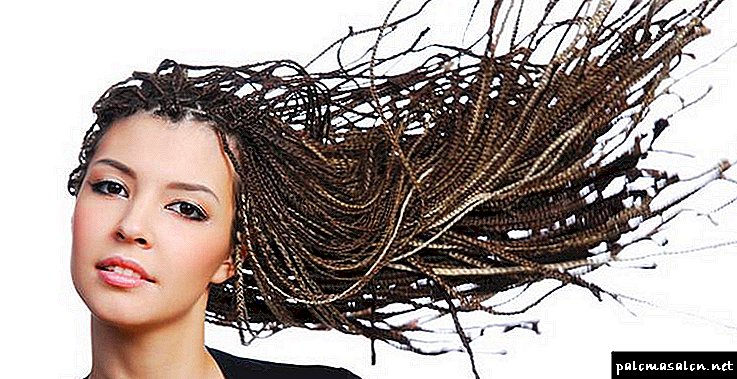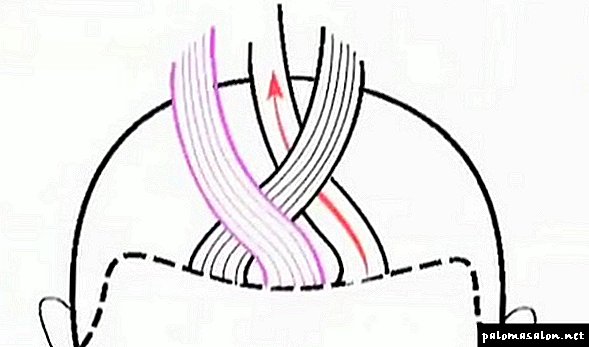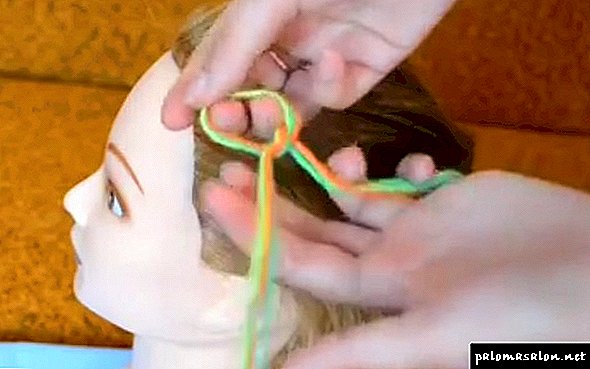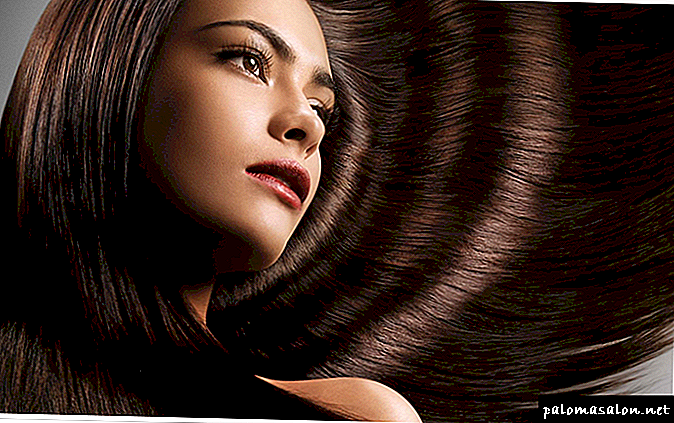
Brades (Afro-braids) is a very comfortable and stylish hairstyle, which is very popular among the fair sex, and which can be done at home.
With it you can safely forget about the debilitating styling every morning, as it itself looks interesting and does not require special attention in terms of care.
What are the types of brades
There are a number of types of braids:
- Pigtails with a straight tip at the end.
- Brands Ponitele - end at a long curled tip.
- Curly (wavy) braids.
- Senegalese harnesses - obtained by twisting the two strands among themselves.
- French patterned pigtails.
- Thai braids.
- Pigtails with large curls.
- Pigtails zizi - are obtained by interweaving pre-harvested plaits.






How to care for them
Afro-brooks do not need anything special in terms of care; it is very easy to keep their decent and clean look. Wash the braids should be no more than once a week.
To do this, use a small amount of shampoo, which is applied directly to the scalp, avoiding excessive contact with the pigtails themselves. After washing the shampoo, the pigtails themselves must be rinsed with a small amount of warm water.
But the use of balms or masks for hair should be avoided, because they will be very problematic to wash, making it difficult to unravel the braids when the time comes.
About the disadvantages
Braid weaving masters and specialists in hairdressing and beauty salons speak positively about braids. Moreover, according to their opinion, such a procedure not only does not harm the hair, but also contributes to the creation of some protection from the effects of harmful factors from the outside.
It is possible to harm the hair only if non-compliance with the technology of weaving afrokosichek, when using dubious materials and the wrong unwinding of this hairstyle.
What you need for braiding weaving
To weave African braids in your home, you only need a lot of patience and equipment in the form of a comb with rare teeth. And also, depending on the weaving technique, there are threads for weaving and elastic bands or glue for gluing afrosholes. Some prefer to solder the ends.
For braiding, preference should be given to special synthetic yarns - Kanekalonu or acrylic knitting yarns.

The advantage of kanekalon is that it is not harmful to hair, does not injure their structure, is diverse in terms of structure and color.
How to weave afrokrosichki at home. Step by step
1. Comb the hair, with the tip of the comb, select a strand of a certain thickness.

2. Comb the strand and divide it into 3 equal parts, holding the side strands with your little fingers, and the central strand with your thumb and index finger.

Hand position: arms and palms down, little fingers closer to the surface of the head.
3. Weaving is done by turning the hand and the palm up, the pigtail is woven through the bottom.


When weaving a pigtail, pull all 3 strands equally, otherwise the pigtail will not be even.
Turn hands alternately: left hand with palm up, right hand palm down. And vice versa: the left palm is down, the right palm is the top. Turn the arm in which there are 2 strands of hair.



Technique weaving afrokrosichek on the surface of the head
1. Separate with two partings sector for weaving.

2. Take a thin strand and divide it into 3 parts.

3. The weaving technique is also through the bottom, but the central strand is connected to the separated sector, capturing a very thin strand from it.



The tension during weaving should be constant: we stretch the side strands to the sides, central to ourselves. Strands form the letter T.

Uniform tension ensures the fit of the afrokosichki to the head.
4. To separate tangled hair at the ends, hold all 3 strands with one hand, and the second stretch along the length of the strand. When connecting hair from the sector, try to avoid overtightening (the hairs should be perpendicular to the braided pigtail.

Pigtail can be braided on the head to any level, then continue weaving away from the surface of the head. Or you can dock to the lower occipital zone (according to your taste). The direction of the braids can be arbitrary.
5. Moving away from the surface of the head, continue weaving the first way. The little fingers are directed towards the head, the central strand is held by the thumb and forefinger.

When weaving the second pigtail, the distance between the partings is arbitrary, but know that the narrower the sector, the thinner the pigtail will be.

Pigtails can start from any point on the surface of the head, you can weave braids of different thickness and arrange them in different directions.
However, one theory is not enough for the correct execution of this procedure. Therefore, you should take some time to practice and find yourself a good helper.
Video: we learn to braid African braids.
How to braid pigtails with threads

For weaving braids, you can use an acrylic thread of any color.
Natural thread is not recommended. Because they fade in the sun and sit on the water, which will damage the hair.
For a pigtail there will be enough three threads, their length count from the length of the hair.
Weaving technique
1. Comb the hair, with the tip of the comb, select a strand of a certain thickness.
2. Bend the threads in half (threads longer than hair by 20-30 cm).

3. Make a free knot.

4. Thread the strand of hair wetted with water into the prepared knot and tighten it as close as possible to the head.

5. Split hair divided into 3 equal parts. For each part, put on 2 strings. There should be 3 strands of braids with two threads each.

6. Further the French braid with small pickups from two parties trudges. For each thread, try to put a small part of the hair.


Variants of the end of weaving can be different, you can fasten with a silicone rubber band or tie threads with a bundle (in the place of a knot, there should be no hair).

Next, trim the ends of the threads. Video tutorial (below) will help to master the technology of weaving with threads faster.
How to braid braid
When the term of wearing afrokosichek has come to an end, the following steps should be taken to unravel them at home:
- remove the pigtail with scissors around the ends of your hair,
- with the help of a fine needle to disassemble the weaving of a pigtail,
- lightly pull the braid in the area of the hair roots so that the pigtail can be easily detached,
- loose hair with fingers
- After removing all the pigtails, the hair should be washed with a restorative shampoo, and then apply a firming mask.
To speed up the process of unwinding, many resort to the help of friends or turn to professionals.
Variations of hairstyles. The average life span of this hairstyle is about three months. So that during this time long braids do not get bored, you should learn how to make different hairstyles from them.




Here is a short list of the most popular:
- Braids braided in one or more thick braids,
- high tail from collected braids,
- brades, twisted into a shell or a bundle,
- tinted braids,
- combine brades with bangs of different shapes.
And this is just a small list of hairstyles available to owners of afrokosichek. Everything determines the flight of fancy, and the braids themselves are very comfortable and pliable to carry out almost any idea.
Video: African braids, afrokostikhek weaving technique.
African braids for short hair.
Features braids
Weaving afrokos involves the use of kanekolona, a special synthetic material that is attached to the hair to give volume, elasticity and length. Externally, it is not much different from the natural head of hair, but much softer, perfectly retains its shape, very easy to use. Experts identify several types of afrokos.
It is a scattering of small braids (100 - 250 pieces), braided in the traditional three-spinning technique. The braids will be thinner, the more beautiful and durable will be the installation itself. Execution time - 3-6 hours.

This is an option for those who can not wait long. Zizi - ready thin braid (diameter - 3 mm, length - 80 cm), which is woven into strands. The initial hair length is no more than 20 cm. The lead time is from 2 to 4 hours. Term socks - from 2 to 4 months. Zizi braids can be made straight, crimped, coiled or twisted.

Represent 10-20 braids, braided in different directions (zigzag, vertically, straight or horizontal) and tight to the head. Braids can create both from natural hair, the length of which is 8-10 cm, and with the addition of synthetic Kanekalon. In the latter version, the pigtails will last longer.
French weaving is in great demand among women and men. It is very convenient to do dancing and active sports with them. Braids from native hair are 1.5 weeks, from artificial yarns - 1.5 months. Weaving time - 40 minutes.

The material for this hairstyle is a thin braid with a round small curl (Ketrin Twist or Ketrin Twist de Lux). Unlike other such braids do not fall in the process of socks. Katherine Twist looks very light and volume.

Curly Curls (afrolocons)
Weave with curls, which are attached to the roots of native hair. The length of the braid is up to 10 cm, the rest is curled in a tight beautiful curl (small, medium or large). Curly curls require regular care - in the first week they will have to be lubricated several times a day with special fixing oil. Then this procedure will need to be repeated after each wash. The required hair length is 10 cm. Lead time - 2-4 hours. Term socks - about 2 months.

Translated from English means "pony tail." These are classic African braids, which are woven from artificial material and end with a small tail. It can be both straight and swirling. The degree of perm and the level of the client chooses. The final laying length is 20-25 cm. Lead time is 5-8 hours.

Artificial braids sewn to natural strands.

Curly braids, reminiscent of wet chemistry. Corrugated kanekalon is used to create them. The diameter of the curl can be anything. Corrugation refers to quick pigtails - weaving time is about 4 hours. It is more convenient to perform it on short hair (5-6 cm) - otherwise the hairstyle will lose its pomp. Term socks - 2-3 months.

They are also called ropes, coils or bundles. Senegalese braids are twisted from two strands. Their length can be any, and a rich palette allows you to create multi-color styling. Weaving takes about 5 hours.

Another subtype of classic Afrokos, for the weaving of which only native strands are taken. The most advantageous Thai braids look on long and fairly thick hair. Another characteristic difference is that the tips of such braids are not sealed with boiling water or fire, but are fastened with a string or a colored rubber band with a bead.

Pros and cons of afrokos
Afropletieniya has several significant advantages, thanks to which they gained such huge popularity:
- Significantly lengthen the short head of hair
- Pigtails with threads change hair color. You can become a brunette, red or blonde, without coloring strands,
- They can be knotted at any time.
- They allow you to create different types of styling,
- Do not require complex care,
- They can even be created on very short hair - 4-7 cm,
- Create a stylish trendy look.
To see this, see the photo before and after.





Unfortunately, afrochichek has its drawbacks:
- They wash badly - even after applying a special shampoo, the hair still remains partially dirty,
- It takes a long time to dry - it takes several hours to dry it. Also, determining whether the strands are dry or not is also very difficult,
- Lacking enough nutrition, natural curls become dull and brittle,
- Affected and increased load on the hair follicles. In most cases, the hair begins to fall out after unraveling,
- First, with such a hairstyle is very uncomfortable to sleep.
Making braids yourself!
How to weave African braids at home? The task is not easy, but with the help of our master class you can handle it without any problems.
- Comb with rare teeth,
- Kanekolon artificial threads,
- Glue, silicone gum or a special device for fixing braids.
Step 1. Comb the hair.
Step 2. Divide it with a comb into equal vertical partings. Their number can be arbitrary and depends on the thickness of the future weaving.
Step 3. On the back of your head take a small strand of hair with a rhomboid parting.
Step 4. Comb it well and attach the Kanekolon thread as close as possible to the roots.
Step 5. Divide the resulting curl into three parts and braid a tight pigtail.
Step 6. Involving the native strands, add a couple more threads so that the finished braid is of the same thickness.
Step 7. Fix the spit tip - it can be soldered, glued or tied with a silicone rubber band.
Step 8. Exactly such a pigtail braid next to this.
Step 9. Continue weaving on the partings in the direction from the neck to the crown. The length, thickness and number of braids determine themselves.
Tip! Do not wash your hair before creating a hairstyle, otherwise the strands will be pushed and crumbled.

African weaving is categorically not suitable for girls with weak, damaged, recently dyed or chemically curled hair. First, it’s harder to work with them. Secondly, such a head of hair needs time to recover, otherwise a fashionable hairstyle can bring only harm.
Afroweaving Care
Caring for African braids is not so difficult. The main thing - to remember a few rules.
- Rule 1. Synthetic threads can not be straightened with an iron, twisted on curlers and dry out with a hair dryer - this adversely affects their condition. You should also refuse to visit a bath or sauna. But the braids can be painted, so if you want to change the hair color, feel free to go to the salon!
- Rule 2. Ideally, a special shampoo is needed for washing the head, but the usual one will do. Dissolve a small amount of the product in a basin with warm water, lower the braids into it and gently rinse them. Pay special attention to the spaces between the weaves. Air conditioning or balm can not be used! To aesthetic hair, repeat the procedure once every 7-10 days.
- Rule 3. Do not wear braids for more than 2.5-3 months.
- Rule 4. If there are protruding hairs, gently cut them with nail scissors. Place them flat, as if cutting the split ends.
- Rule 5. If you are not satisfied with the length of braids, cut them to the desired level.
- Rule 6. Afrokos with threads adjusted in the cabin - preferably one master.
As the photos show, African braids can make a lot of light and stylish styling. Most often they are worn loose, fixed with a wide bandage or tied with a knot at the back of the head. But that's not all! High or low tail, a large and lush beam, a wide spit - there are a lot of options!








How to weave afrokosy?
If necessary, you can remove afrokos without the help of outsiders:
1. Cut the threads from the ends of the hair.
2. Armed with a needle or an awl, unravel weaving.
3. Gently pull the pigtail around the roots to release the thread.
4. Untangle the strands with your hands and remove the Kanekolon thread.
5. Wash your hair with a revitalizing shampoo and firming balm.
How to weave African braids?
Weaving African braids is a long and laborious process. In order to braid such braids, it is necessary to have a length of your own hair of at least 5 cm. And both artificial hair and cotton threads can be woven into the pigtails themselves.The color of the threads may be the most diverse, but it is recommended to adhere to its natural color. At will it is possible to dilute color with light or dark threads.
Many girls are afraid of braiding African braids with threads, believing that after them their hair is very spoiled. But this is a common myth, since the threads are very light, and it does not burden the native hair. For those who are interested in how to weave African braids, we provide detailed instructions:
- It is necessary to carefully comb all the hair. Then divide the entire area of hair into partings. There can be many partings - it all depends on the thickness of the braided pigtail.
- In the back of the head you need to select a small diamond-shaped area. After careful brushing, it is necessary to fix the thread as close as possible to the hair roots.
- The resulting strand must be divided into three equal parts and proceed to weave an elastic braid.
Each girl herself determines the length and number of braids that she wants. The weaving itself comes from the neck of the head to the crown. The tips of the braids can be glued together, tied with rubber bands or put beads on them.

How to make Braid at home
In order to braid African braids at home, it will take a lot of effort and time. Unprepared girls, this procedure at home may not like at all. Best of all, when there are assistants who will be happy to help, there will be no extra pair of hands. The procedure itself is performed in the same way as in the salon, except that you yourself carry out the procedure on your hair.
To braid African braids at home, relying on one theory is not enough - it is necessary to pay more attention to practice. Only by “filling” the hand, you can braid yourself braids. In all other cases, it is better to turn to professionals - it will save you time and nerves.

Care for African braids
African braids do not need any special care. Moreover, this hairstyle does not need to be washed as often as regular hair. But it is worth being careful and not to use a hair dryer and any other heat treatment on the hair - this can significantly affect the external state of the threads.
In order to wash your hair, you should apply a small amount of shampoo diluted with water on the scalp. No need to carefully rub the braids themselves - this may lead to deformation of some plexuses. If the braids are long, then try not to lather the whole head at all. The main task is to wash the scalp, but do not touch the hair itself.

Braid of African braids
How to weave African braids. we have already learned. And how to unstick them? It is best to unravel braids from a professional who quickly and efficiently removes braids. Answering the question about how to weave African braids on your own, we suggest to start cutting off the braids before growing your own hair - this is how you shorten the procedure significantly. Next, use for unwinding any sharp tools such as knitting needles or awls. Begin to unravel the braid through your hair, approaching the roots. For horses, just pull the strands of the pigtails toward you - it will easily peel off.
Immediately it should be said that after unwinding, you can be surprised at the amount of lost own hair. But do not be afraid, because while you wore afrokosy, hair continued to fall as well as grow, these are completely natural processes. If you wore afrokos correctly and removed them properly, without damaging the structure of the hair, after removing the hair will look like a regular braids.

Correction of african braids
In order for the braids to maintain a good appearance longer, it is necessary to carry out a correction after some time. You can do it yourself: it is enough for this to cut out of the braids protruding hairs that are pushed. So they will look more well-groomed and even. If you first braid the braids by one length, and then it seemed too long for you, then you can independently trim the braids to the desired size. Also, if desired, you can paint the braids in any color you like. It is worth knowing that the African braids with threads need to be adjusted from time to time in the cabin where the weaving was made. Due to the master's correction, it is possible to extend the time of wearing the braid for several months.

Haircuts with African braids
How weave African braids, we already know. Now it's time to figure out how to wear them. Hair with braids can be worn loose or braided in a high tail. It should be understood that long braids will be a little hard to put together in any hairstyle, so you can ask your friend for help.
Perfectly look loose spit with wide bandages. You can make a big bundle that will look like a bird's nest on your head. Also originally looks a braid of small braids. When such original braids are braided, you can experiment with hairstyles as many as you want!
This hairstyle is perfect for summer and for winter. Afrokosy protect hair from exposure to harmful factors such as sunlight, dirt, dust.

Afrokosy allow you to look very stylish and original. Such pigtails do not need special care, which may especially appeal to girls who value their time. Weaving African braids is not so difficult, but how much benefit it can bring! Especially such braids can be attractive for girls with short hair, because thanks to the interweaving of the threads you can "get" long hair.



